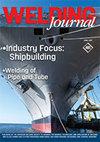高强度钢焊接金属的韧性
IF 1.4
3区 材料科学
Q2 METALLURGY & METALLURGICAL ENGINEERING
引用次数: 2
摘要
低温相变(LTPT)焊接耗材是一种新型焊丝,旨在缓解高强度钢焊接中的氢致开裂,而无需预热或焊后热处理。LTPT焊接金属具有较高的强度,但其韧性需要进一步研究。LTPT焊接金属主要包含马氏体微观结构,这对于实现高强度是必要的;然而,含有氧化物夹杂物的马氏体焊缝金属具有相对较差的韧性。研究了三种焊接工艺——气体保护金属极电弧焊(GMAW)、钨极气体保护焊(GTAW)和热丝GTAW。采用光学显微镜、扫描电子显微镜和透射电子显微镜进行表征。研究了保护气体在LTPT焊缝金属中氧化物夹杂物形成中的作用。焊接金属中氧化物夹杂物的形成与保护气体中的CO2有关。当所有三种焊接工艺都使用100%Ar或纯惰性保护气体混合物时,氧化物夹杂物大大减少,焊缝金属韧性显著提高,与母材金属韧性相匹配。提出了夹杂物促进焊缝金属断裂扩展的机理。本文章由计算机程序翻译,如有差异,请以英文原文为准。
The Toughness of High-Strength Steel Weld Metals
Low-temperature phase transformation (LTPT) welding consumables are a new class of welding wires developed to mitigate hydrogen-induced cracking in the welding of high-strength steels without preheating or postweld heat treatment. LTPT weld metals have a high strength, but their toughness needs further investigation. LTPT weld metals predominately contain a martensite microstructure, which is necessary to achieve high strength; however, martensitic weld metals containing oxide inclusions have relatively poor toughness. Three welding processes — gas metal arc welding (GMAW), gas tungsten arc welding (GTAW), and hot wire GTAW — were investigated. Optical microscopy, scanning electron microscopes, and transmission electron microscopes were employed for characterization. The role of the shielding gas in the formation of oxide inclusions in LTPT weld metals was investigated. The formation of oxide inclusions in the weld metals was related to the CO2 in the shielding gas. When 100% Ar or a pure inert shielding gas mixture was used for all three welding processes, oxide inclusions were greatly reduced, and the weld metal toughness improved considerably, matching the base metal toughness. The mechanism by which inclusions promote fracture propagation in the weld metal was proposed.
求助全文
通过发布文献求助,成功后即可免费获取论文全文。
去求助
来源期刊

Welding Journal
工程技术-冶金工程
CiteScore
3.00
自引率
0.00%
发文量
23
审稿时长
3 months
期刊介绍:
The Welding Journal has been published continually since 1922 — an unmatched link to all issues and advancements concerning metal fabrication and construction.
Each month the Welding Journal delivers news of the welding and metal fabricating industry. Stay informed on the latest products, trends, technology and events via in-depth articles, full-color photos and illustrations, and timely, cost-saving advice. Also featured are articles and supplements on related activities, such as testing and inspection, maintenance and repair, design, training, personal safety, and brazing and soldering.
 求助内容:
求助内容: 应助结果提醒方式:
应助结果提醒方式:


